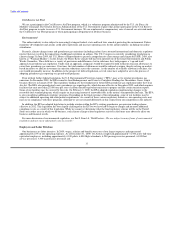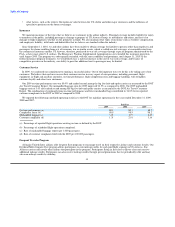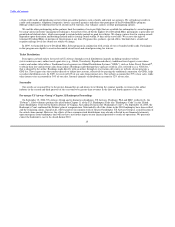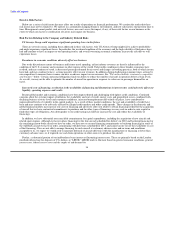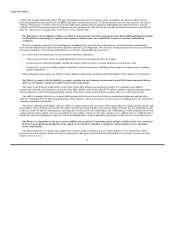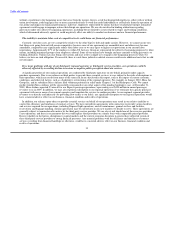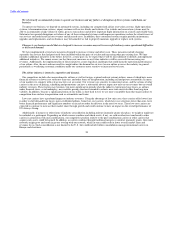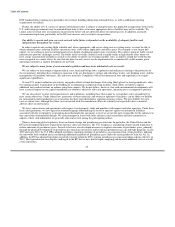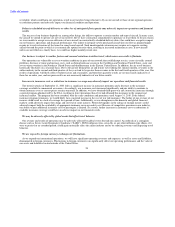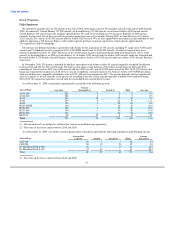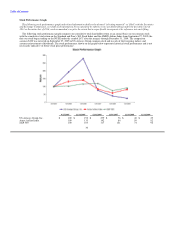US Airways 2009 Annual Report Download - page 22
Download and view the complete annual report
Please find page 22 of the 2009 US Airways annual report below. You can navigate through the pages in the report by either clicking on the pages listed below, or by using the keyword search tool below to find specific information within the annual report.
Table of Contents
We rely heavily on automated systems to operate our business and any failure or disruption of these systems could harm our
business.
To operate our business, we depend on automated systems, including our computerized airline reservation systems, flight operations
systems, telecommunication systems, airport customer self-service kiosks and websites. Our website and reservation systems must be
able to accommodate a high volume of traffic, process transactions and deliver important flight information on a timely and reliable basis.
Substantial or repeated disruptions or failures of any of these automated systems could impair our operations, reduce the attractiveness of
our services and could result in lost revenues and increased costs. In addition, these automated systems require periodic maintenance,
upgrades and replacements, and our business may be harmed if we fail to properly maintain, upgrade or replace such systems.
Changes to our business model that are designed to increase revenues may not be successful and may cause operational difficulties
or decreased demand.
We have implemented several new measures designed to increase revenue and offset costs. These measures include charging
separately for services that had previously been included within the price of a ticket and increasing other pre-existing fees. We may
introduce additional initiatives in the future, however, as time goes on, we expect that it will be more difficult to identify and implement
additional initiatives. We cannot assure you that these new measures or any future initiatives will be successful in increasing our
revenues. Additionally, the implementation of these initiatives creates logistical challenges that could harm the operational performance
of our airline. Also, the new and increased fees might reduce the demand for air travel on our airline or across the industry in general,
particularly as weakening economic conditions make our customers more sensitive to increased travel costs.
The airline industry is intensely competitive and dynamic.
Our competitors include other major domestic airlines as well as foreign, regional and new entrant airlines, some of which have more
financial resources or lower cost structures than ours, and other forms of transportation, including rail and private automobiles. In many
of our markets we compete with at least one low cost air carrier. Our revenues are sensitive to numerous factors, and the actions of other
carriers in the areas of pricing, scheduling and promotions can have a substantial adverse impact not only on our revenues but on overall
industry revenues. These factors may become even more significant in periods when the industry experiences large losses, as airlines
under financial stress, or in bankruptcy, may institute pricing structures intended to achieve near-term survival rather than long-term
viability. In addition, because a significant portion of our traffic is short-haul travel, we are more susceptible than other major airlines to
competition from surface transportation such as automobiles and trains.
Low cost carriers have a profound impact on industry revenues. Using the advantage of low unit costs, these carriers offer lower fares
in order to shift demand from larger, more-established airlines. Some low cost carriers, which have cost structures lower than ours, have
better financial performance and significant numbers of aircraft on order for delivery in the next few years. These low-cost carriers are
expected to continue to increase their market share through growth and could continue to have an impact on the overall performance of
US Airways Group.
Additionally, if mergers or other forms of industry consolidation including antitrust immunity grants take place, we might or might not
be included as a participant. Depending on which carriers combine and which assets, if any, are sold or otherwise transferred to other
carriers in connection with such combinations, our competitive position relative to the post-combination carriers or other carriers that
acquire such assets could be harmed. In addition, as carriers combine through traditional mergers or antitrust immunity grants, their route
networks might grow and result in greater overlap with our network, which in turn could result in lower overall market share and
revenues for us. Such consolidation is not limited to the U.S., but could include further consolidation among international carriers in
Europe and elsewhere.
20



